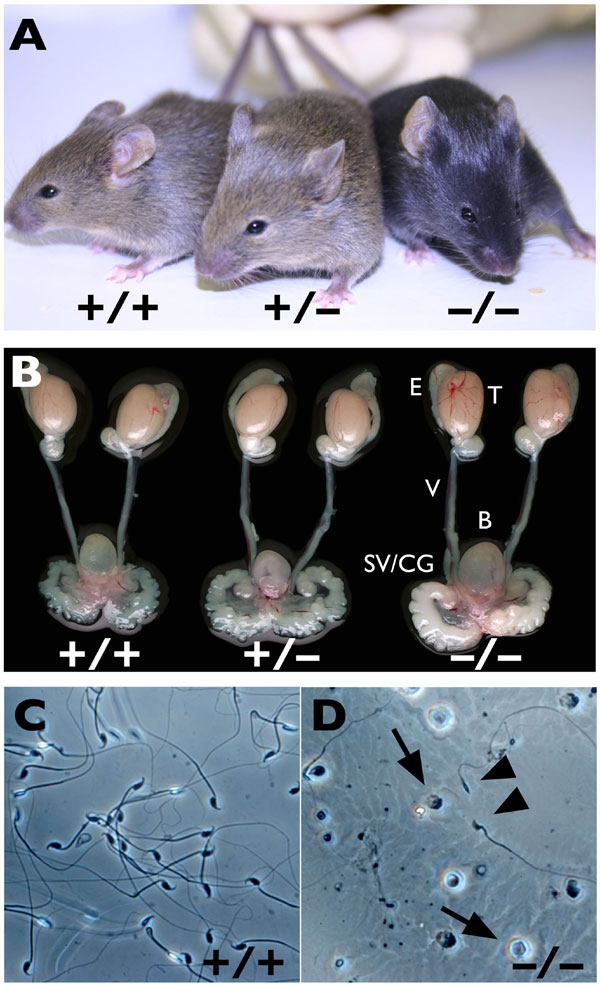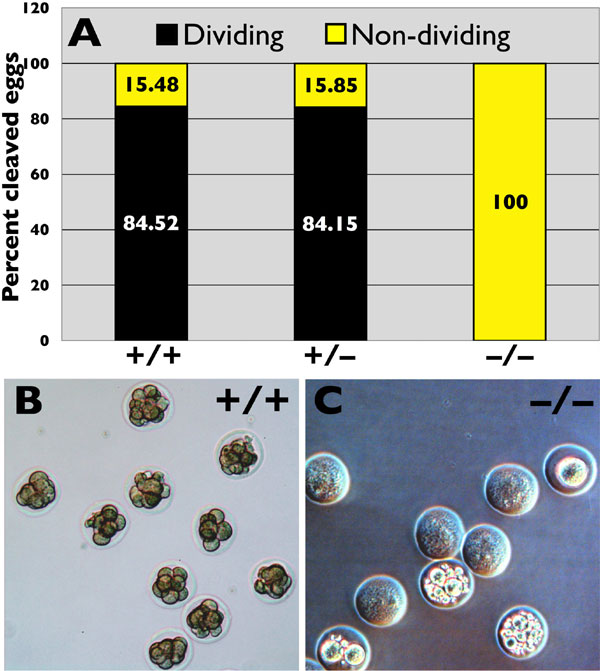Loss of polyadenylation protein Ï„CstF-64 causes spermatogenic defects and male infertility
Dass et al. 10.1073/pnas.0707589104.
Supporting Information
Files in this Data Supplement:
SI Figure 5SI Movie 1
SI Movie 2
SI Figure 6
SI Table 4
SI Table 5
SI Table 6

Fig. 5. Cstf2t-/- mice show no morphological differences from wild type. (A) Cstf2t+/+ (Left), Cstf2t+/- (Center), and Cstf2t-/- (Right) mice are indistinguishable by body size (see Table 1), behavior, or other overt characteristics (note that coat color is arbitrary and not distinguishing in these mice). (B) Gross anatomy and weights of reproductive organs are indistinguishable between Cstf2t+/+ (Left), Cstf2t+/- (Center), and Cstf2t-/- (Right) mice. E, epididymis; T, testis; V, vas deferens; B, bladder; SV/CG, seminal vesicle and coagulating gland. (C and D) Cauda epididymal sperm from Cstf2t+/+ (C) and Cstf2t-/- (B) mice. Arrows indicate round cells (probably prematurely released round spermatids); arrowheads indicate spermatozoa with abnormal head morphology.

Fig. 6. Cstf2t-/- male mice are unable to fertilize oocytes in vivo. (A) Stacked bar graphs showing the percentages of dividing embryos (black) and uncleaved or degenerating one-cell oocytes (yellow) obtained from the oviducts of adult CD1 females mated with Cstf2t+/+, Cstf2t+/-, or Cstf2t-/- males. Data consists of 84 oocytes from mating with two Cstf2t+/+males, 82 oocytes from mating with four Cstf2t+/- males, and 155 oocytes from mating with six Cstf2t-/- males. (B and C) Representative images obtained at 3 days postcoitus of eight-cell and morula-stage embryos obtained from mating with a Cstf2t+/+male (B) and of nondividing oocytes obtained from mating with a Cstf2t-/- male (C). (Magnification, ´25.)
Fig 7. Cstf2t Top Bottom
SI Movie 1
Movie 1. Representative movie of spermatozoa from the epididymis of a Cstf2t+/+ mouse. Note that nearly all spermatozoa are motile and regularly shaped.
SI Movie 2
Movie 2. Representative movie of spermatozoa from the epididymis of a Cstf2t-/- mouse. Note the large number of round cells (prematurely sloughed round spermatids) and other debris. However, few motile spermatozoa can be seen.